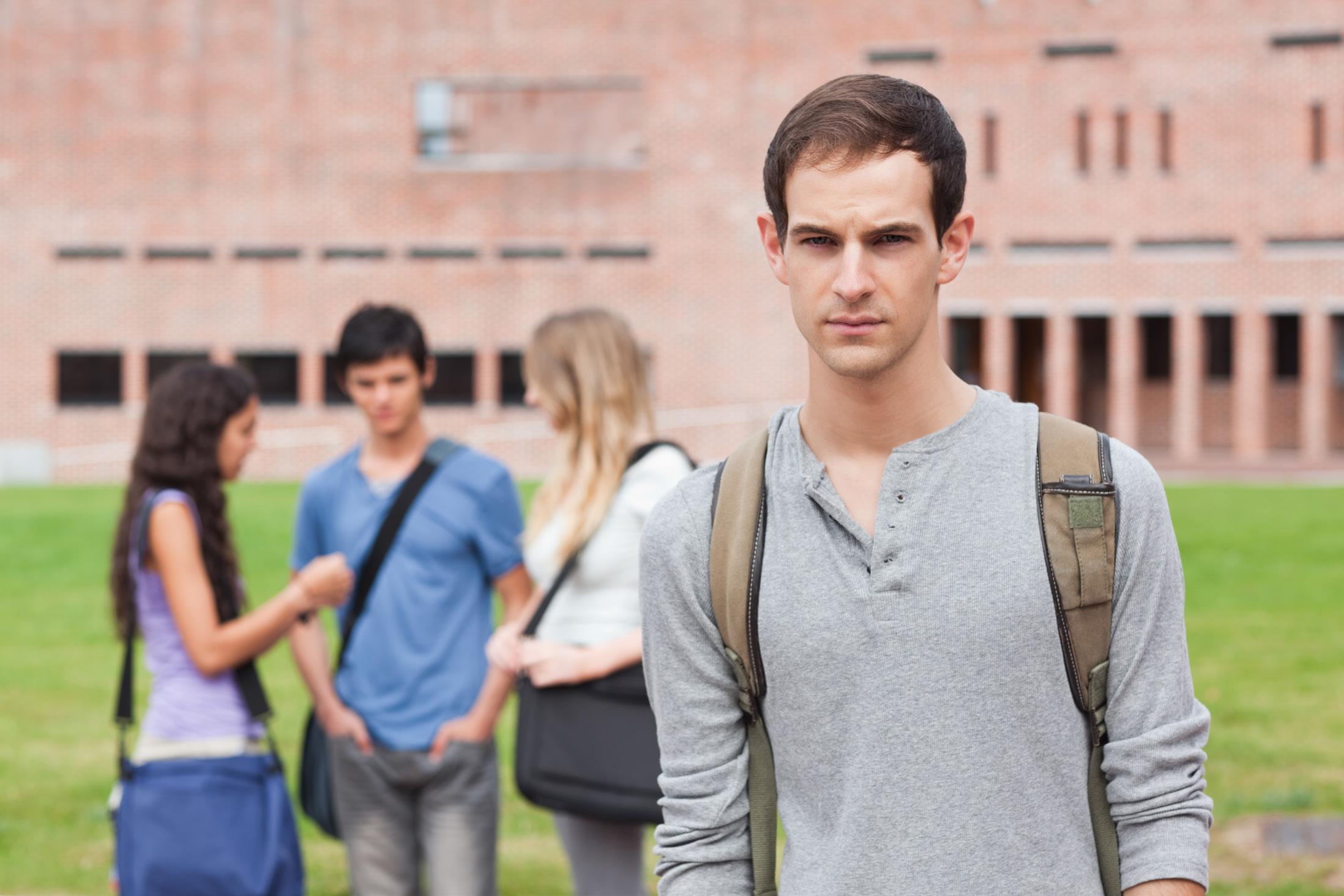
13 minute read
DO STUDENTS ON THE AUTISM SPECTRUM FEEL INCLUDED IN THE SCHOOL SYSTEM?
Do Students on the Autism Spectrum
Feel Included in the School System?
By Stephanie C. Holmes, BCCC, Certified Autism Specialist
ACCORDING TO AVAILABLE RESEARCH AND ANECDOTAL EVIDENCE IN MY OWN PRACTICE, STUDENTS ON THE AUTISM SPECTRUM ALREADY WERE FEELING ISOLATED AND EXCLUDED BEFORE WE WENT INTO LOCKDOWN AND LIFE TURNED UPSIDE DOWN. HOW HAS COVID-19 IMPACTED STUDENTS ON THE SPECTRUM? FIRST, LET’S DISCUSS STUDENTS’ PERSPECTIVES OF THEIR SCHOOLING PRIOR TO THE PANDEMIC.
In my dissertation research completed this year, Creating an Inclusive Climate for Students on the Autism Spectrum (Holmes, 2020), seven students participated in the qualitative research on their experience in the public school system. While this number seems small, in qualitative research, five to eight persons are required for studying a phenomenon or experience of a specific population (Leavy, 2017). It is important to note the students represented both males and females, autism levels one, two, and three, and the students were 18 or older. Some had qualifiers of non-speaking, learning differences and disabilities, selective mutism, and other anxiety disorders. It is also very important to note this study, while on a vulnerable population, met the criteria and scrutiny of the Institutional Review Board’s ethical practices for my program of study.
The purpose of the study was to examine barriers to inclusive practices and hear from administrators, teachers, paras, school counselors and psychologists, other specialists, parents, and students on the spectrum. This article will discuss the perspective of the student as their voices are not often included in discussing best-practices for what they would define as inclusion. A subsequent article will discuss ideas from these students for better inclusive practices.
What barriers were described by students on the autism spectrum?
It is not a surprise that students who struggle with social interactions would be easy targets of bullying (Elliott, Hwang, & Wang, 2019; Sofronoff et al., 2011), especially by queen bees or other ringleader bullies (Smith, 2017; Stellwagen, 2013; Sutton, Smith & Swettenham, 2001). Current research of ringleader or queen bee bullies indicates these individuals have high theory of mind skills and manipulate vulnerable individuals. They have an ability to often get away with doing so because they are seen as leaders or prosocial in their schools (Lonigro, Laghi, Baiocco, & Baumgartner, 2014; Sutton, Smith & Swettenham, 2001).
However, research reveals students on the spectrum are not only bullied by peers but sometimes are bullied by or experience negative biases from educators and staff who have a lack of understanding of autism and other disabilities (Ernsperger, 2016). Zero-tolerance policies concerning behavior are especially harmful to students on the spectrum and other disabilities and tend to end up targeting vulnerable students because of behavioral challenges (which are usually communication issues more than behaviors to manage) that may occur with autism (Ernsperger, 2016).
The students interviewed had mixed feelings about their school experience; the female students became anxious and emotional when recounting incidents that happened at school. However, all the students in the study felt disconnected from the student population and that most of their teachers or administrators did not understand them or autism.
Quotes from students in the study
(Holmes, 2020, pp. 134-146)
Student One said, “I was different [at school]—that is not the thing to be. I was never invited to do much of anything. I was the odd kid out.” When asked what you want teachers to know, she replied, “Autism is not always easy to see,” and she added that teachers first need to understand autism and then get to know their students individually to understand how to best support them. She also felt that pull out resources are embarrassing for middle and high school students and adds to the stigma. She suggested since many students on the spectrum have special interests, why not allow them to do projects or share and feel competent in front of their peers of subjects in which they have become expert. She felt the school could do a better job bridging the gap between autistic students and the overall population.
Student Two noted, “I had a bunch of bullying during my freshman and junior years. I felt ignored and left out at school in middle school and high school.” She discussed that in elementary school, the Autism Society of her state visited the school and did inclusion classes, and she felt she had friends in elementary school but was disliked and abused by various teachers. The situation changed in middle and high school, where she felt teachers were more aware of her and included her, but the students did not.
It was confusing that peers she interacted with in other clubs and Girl Scouts were friendly when adults were around in these groups yet excluded or bullied her in other situations in school. When asked what teachers could do better, she said
This table was listed as Appendix L in the dissertation study and represents the top barriers noted by students on the spectrum.
Recurring Remark/Theme
Did not feel safe physically or emotionally at school Did not feel wanted or included by the student body Lack of peer awareness of autism Lack of teacher understanding of autism/lack of individualization Experienced teasing for autistic mannerisms or behaviors Experienced verbal bullying *Lack of social supports or social skills building *Lack of social skills or supports mentioned in IEP Experienced exclusion Was not invited to outside parties or events How I was treated by peers/teachers was detrimental to my mental health Felt stigmatized for my autism Was treated as a non-person by school/peers/staff (Treated like a toddler, monster, burden, alien, animal, problem, outcast, bomb/explosion)
# of Students
7/7 7/7 7/7 7/7 7/7 7/7 6/6 6/6 6/7 6/7 6/7 6/7 5/7
*One student from Canada was diagnosed late in school life and did not have IEP, and therefore did not qualify for all questions.

teachers should be educated and lead the way in breaking the stigma for students with differences. She suggested peer training should be at every level of school.
Student Three communicated with a letter board and stated his frustration with teachers assuming he was nonverbal. “Nonverbal indicates non-thinking, which cannot be further from the truth for non-speaking autistics like me. It indicates having no language. I have complete receptive language but cannot output my thoughts due to motor planning deficits. As this recording demonstrated, I can speak [meaning verbally] per se but not reliably or meaningfully. (Note: Person Three would speak a word he was spelling on his letterboard and keep repeating that same word over and over as he continued to point and spell out his thoughts on the letterboard). The majority of the time [at school], I was treated or spoken to or through as if I were a toddler.” When asked if he felt included at school, he responded emphatically on his letter board, “NO!”
Student Three experienced physical abuse at the hand of a para, and he further described his experience as, “It was a nightmare and a joke all rolled into one. And that was with extremely involved and aware parents trying to make the right thing happen. The system is significantly broken. Teachers who are real advocates for students are pressured not to be. The most disturbing thing is that once the error of their ways is pointed out, they still don’t want to do the right thing. I haven’t even touched on the irreversible damage their restraints and behavior programs produce. Parents who send their non-speaking autistic child to public schools do so at great peril to their child. My body can behave badly at times, largely out of my intentional control. It is more likely to do so when I am stressed, anxious, demeaned, and ridiculed. It becomes a vicious cycle, and I am viewed as a monster.” He was adamant that letter boards and other communication devices be allowed for non-speaking individuals and allow the student choice in what communication method works for them, even if it is inconvenient to the school.
Student Four described herself as academically successful but did not feel school was a safe place to be herself. She felt she had to mask. Teachers treated her kindly because she was a star student, but peers were not welcoming or inclusive. She is now a teacher, and when asked how schools can be more inclusive, she responded, “For peers, explaining at an age-appropriate level, you know their classmates’ needs.” She clarified that teachers could not give out confidential information but simple details and explanations like, “Bright lights really bother Johnny, so we are going to keep the lights dimmer.” If students press for why as students do, she advised offering a simple explanation, “Johnny’s brain works differently, so

that’s why he does this, and when he does this, we can help him by…” She wanted to spread knowledge to teachers and peers. She also stated teachers need to lead the way with inclusion by educating themselves and advocating for their students.
Student Five was diagnosed in high school after a traumatic experience. She was doing dual enrollment classes at a local college and was taken advantage of by a student at the college. He took advantage of her naivety, and she was unable to read the social cues that she was in danger. Because she was accelerated academically and shy, her Asperger’s was missed.
When I first asked if she had been bullied at her high school, she said no, but asked if this scenario counted. She described, “A lot of what they did bordered between those [bullying and teasing]. It definitely started as teasing. There were points where that did turn into what I would consider bullying, where some of the older males from the group would back me into a corner. There were times I was left hyperventilating on the ground, even in front of the teacher, who then walked out of the room and left me hyperventilating on the ground in a panic attack. I think she thought I was faking it because she was laughing. It wasn’t funny. I was not faking it. There was one time I clearly remember being hit with a yardstick across my hand. I learned later one of the reasons one of the guys did this was because it was funny, and it was entertaining to him.” She suggested mentor programs and extra peer supports for teens on the spectrum while saving face. She felt students were not really included in their IEP process, and many students with autism do not know what to ask for in the way of supports.
Student Six had moderate autism and processing delays. He said he felt excluded throughout his entire school life. He felt like people disregarded him because of his differences, and he desperately wanted a friend and to be included. He was nervous about our interview and struggled at times to articulate things, but he came prepared with something he wrote and wanted included in the study. He wrote, “There’s so much stigma with autism, and it has to stop. Some autistics are still being forced to hide themselves. For example, if an autistic does something out of the ordinary or makes mistakes, people tell them that they don’t want to be friends or whatever. Society can force their way upon others who are different to hide or mask their autism. That’s not how it works, though, at least not in any way that’s healthy. There shouldn’t be a stigma. When you are accepting to be someone’s friend, you should accept and try to understand all aspects of a person. We autistics shouldn’t feel the need to hide anything. People view autism as a source of annoyance, disappointment, or worse in different ways to different degrees. It’s not fair
to place judgment upon someone when you don’t even fully know them. Having a true friend is having someone who accepts you for you, regardless of your flaws.”
Student Seven said she disliked high school, and just speaking about it brought her to tears. She said back in the early 2000s, teachers were even less aware of autism in females. She was diagnosed in middle school and recounted how she found out about her diagnosis. Her mother told her teacher and asked him not to tell her—that her therapist would be doing so—but asked what supports could be in place. She recounted the story, “He [the teacher] took me out of the room with the teacher aid, and he proceeded to tell me that I was damaged in the brain, and I was never going to amount to anything, and this is why all the other kids hated me. This is why I would never be able to go to college or amount to anything, worth anything, basically. That I never would be normal and probably was going to end up in a group home someday, and I would never be able to take care of myself or make money. Essentially, I should just give up now, basically.” She stated that she wants peers and teachers to understand their words have impact and can damage people. She felt her teachers were not educated or accepting of autism. She wanted teachers to know that when you treat a student poorly, you are essentially allowing that same behavior in students, and this can significantly affect mental health and self-esteem.
As you read, students on the spectrum were struggling and felt they were not supported long before COVID greatly impacted the services students were receiving. Clients on the spectrum indicated that COVID really exacerbated the feeling of loneliness and isolation because, as one said, “No one ever checks in on me from my school, and I realized I really did not have true friends. I was being tolerated.”
During my dissertation study, there were very few articles or research that included voices from students on the spectrum, and this is a travesty. In the name of protecting a vulnerable population, these voices are often missing from research. Students on the spectrum have ideas about inclusion and better practices if we are willing to listen.
REFERENCES
Elliott, S., Hwang, Y. S., & Wang, J. (2019). Teachers’ rating of social skills and problem behaviors as concurrent predictors of students’ bullying behavior. Journal of Applied Developmental Psychology, 60, 119-126. doi:10.1016/j.appdev.2018.12.005 Ernsperger, L. (2016). Recognize, respond, report: Preventing and addressing bullying of students with special needs. Baltimore, MD: Paul H. Brookes. Holmes, S. (2018). Creating an inclusive climate for students with developmental delays (AS/ASD). Georgia Association for Positive Behavior Support Conference. Retrieved from https:// digitalcommons.georgiasouthern.edu/cgi/viewcontent.cgi?article=1303&context=gapbs Holmes, S. (2020). “Creating an Inclusive Climate for Students on the Autism Spectrum” (2020). School of Educational Leadership. 5. https://digitalcommons.acu.edu/school_ed_leadership/5 Leavy, P. (2017). Research design: Quantitative, qualitative, mixed methods, arts-based, and community based participatory research approaches. New York, NY: The Guilford Press. Lonigro, A., Laghi, F., Baiocco, R., & Baumgartner, E. (2014). Mind reading skills and empathy: Evidence for nice and nasty ToM behaviours in school-age children. Journal of Child & Family Studies, 3, 581-590. doi:10:10.1007/s10826-013-9722-5 Smith, P. (2017). Bullying and theory of mind: A review. Current Psychiatry Reviews, 13(2), 90- 95. Retrieved from https://doi.org /10.2174/1573400513666170502123214 Sofronoff, K., Dark, E., & Stone, V. (2011). Social vulnerability and bullying in children with Asperger syndrome. International Journal of Research and Practice, 15(3), 356-372. doi:10.1177/1362361310365070 Stellwagen, K. K. (2013). Ringleader bullying: Association with psychopathic narcissism and theory of mind among child psychiatric inpatients. Journal of Autism and Developmental Disorders, 44(5), 612-620. doi:10.1007/s10578-012-0355-5 Sutton, J., Smith, P., & Swettenham, J. (2001). Bullying and ‘theory of mind’: A critique of ‘social skills deficit’ view of anti-social behavior. Social Development, 8(1), 117-127. https://doi. org/10.1111/1467-9507.00083
Dr. Stephanie C. Holmes, BCCC, is a professional counselor, educator, researcher, author, and certified autism specialist with neurodiversity training. However, her real credential comes from being a mother to an amazing young adult Aspie (AS) daughter. Dr. Holmes’ career focus changed in 2004 when her daughter was diagnosed with Asperger’s (now AS Level One). Her book Confessions of a Christian Counselor was released in 2015 and is available on Amazon. Dr. Holmes is available for consulting, training, and speaking at www.HolmesASR.com. She is the interim host of Converge Autism Radio, where topics of autism from childhood to adulthood are covered.










